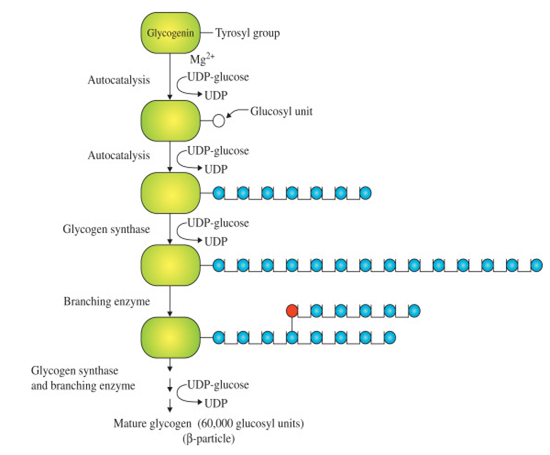Glykogen Chemische Eigenschaften,Einsatz,Produktion Methoden
R-S?tze Betriebsanweisung:
R36/37/38:Reizt die Augen, die Atmungsorgane und die Haut.
S-S?tze Betriebsanweisung:
S24/25:Berührung mit den Augen und der Haut vermeiden.
S26:Bei Berührung mit den Augen sofort gründlich mit Wasser abspülen und Arzt konsultieren.
Chemische Eigenschaften
White to off-white powder
Verwenden
glycogen is a skin-conditioning agent. It is a high molecular-weight polymer distributed through the cell protoplasm.
Definition
A
polysaccharide that is the main carbohydrate
store of animals. It is composed of
many glucose units linked in a similar way
to starch. Glycogen is readily hydrolyzed in
a stepwise manner to glucose itself. It is
stored largely in the liver and in muscle but
is found widely distributed in the body.
Allgemeine Beschreibung
Glycogen is a branched polymer of glucose synthesized by animal cells for energy storage and release. It is constructed of predominantly α1→4 glycosidic bonds with branches created through α1→6 glycosidic bonds.
Synthese
Glycogen synthesis occurs in the cytoplasm and can be divided into the following four steps:
(1) Glycogenesis begins with the phosphorylation of glucose by glucokinase in the liver and by hexokinase in muscle and other tissues.
(2) Glucose-6-phosphate is then converted into glucose-1-phosphate by phosphoglucomutase, a reaction similar to that catalysed by phosphoglycerol mutase.
(3) Glucose-1-phosphate is converted into uridine diphosphate (UTP)-glucose, the immediate precursor of glycogen synthesis, by reaction with uridine triphosphate (UTP). This reaction is catalysed by glucose 1-phosphate uridylyltransferase (or UDP-glucose pyrophosphorylase).
(4) Finally, the glucosyl residue at the C-1 position of UDP-glucose is added to the tyrosyl group at position 194 of glycogen protease in an Mg2+-dependent autocatalytic reaction. Glycosidases similarly extend the glucan chain by α(1→4) glycosidic bonds by adding 6 to 7 glucosyl units, using UDP-glucose as the substrate, in an autocatalytic reaction. The glucan primer of glycogen proteins is elongated by glycogen synthase using UDP glucose. Initially, the glycogenin primer and glycogen synthase are strongly bound using a 1:1 complex. As the dextran chain grows, glycogen synthase separates from glycogen.

l?uterung methode
A 5% aqueous solution (charcoal) of D(+)-glycogen is filtered, and an equal volume of EtOH is added. After standing overnight at 3o the precipitate is collected by centrifugation, washed with absolute EtOH, then EtOH/diethyl ether (1:1) and diethyl ether, and dried. [Sutherland & Wosilait J Biol Chem 218 459 1956.]
Glykogen Upstream-Materialien And Downstream Produkte
Upstream-Materialien
Downstream Produkte

